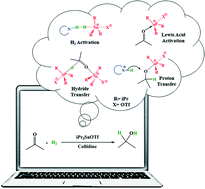Unravelling the mechanism of tin-based frustrated Lewis pair catalysed hydrogenation of carbonyl compounds†
Abstract
This article presents a comprehensive study on the mechanism of Sn/N frustrated Lewis pair (FLP) catalysed hydrogenation of carbonyl compounds to corresponding alcohols. Possible reaction pathways have been elucidated in detail using density functional theory computations. The reaction begins with Sn/N FLP-mediated heterolytic cleavage of a H2 molecule to release active hydrogens in solution. Our results reveal that, instead of the usual Brønsted acid activation, the carbonyl substrate is activated by Lewis acid complexation, followed by subsequent hydride and proton delivery to complete the hydrogenation process. Additionally, we have also examined the feasibility of an autocatalytic pathway. The main feature of this reaction route is Sn/O FLP-mediated H2 cleavage, which has a comparable barrier to H2 splitting by Sn/N FLPs. Overall, our computational mechanistic model is consistent with the experimental findings and the computed free energy barriers are in good agreement with the observed reactivity at experimental temperature. Insights obtained from this study are crucial for the rational development of Sn-based FLP hydrogenation catalysts.



 Please wait while we load your content...
Please wait while we load your content...